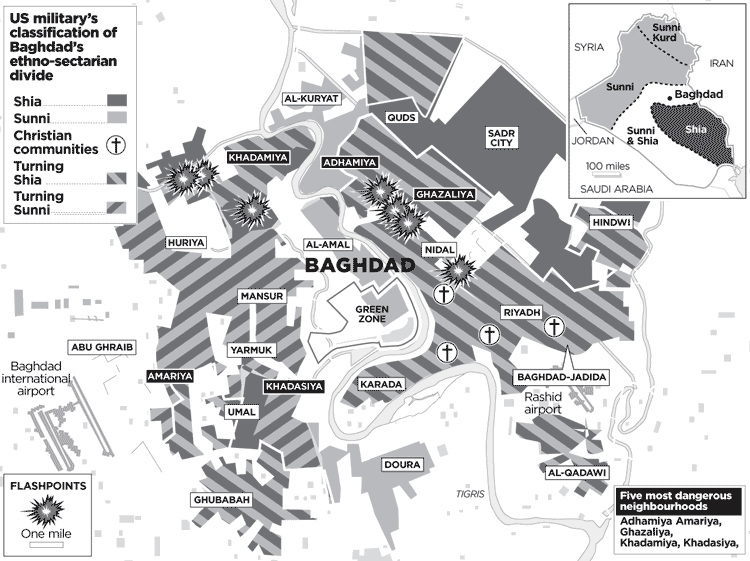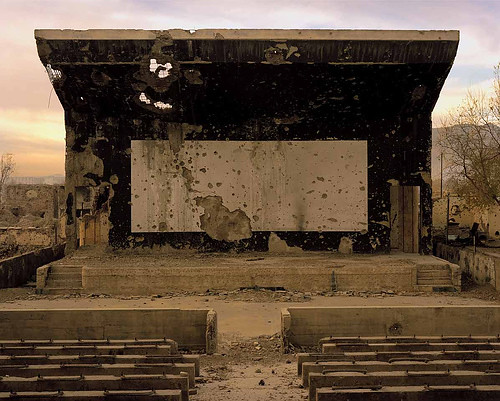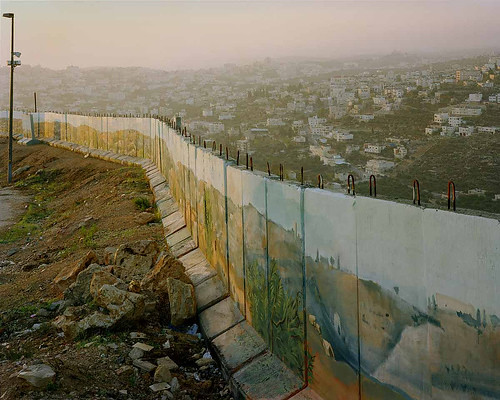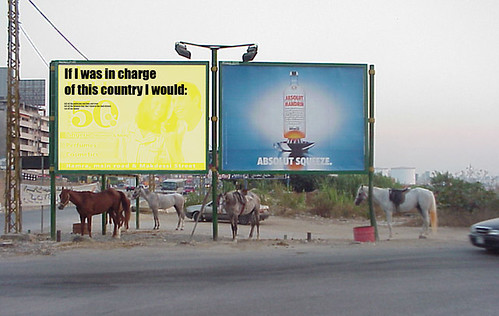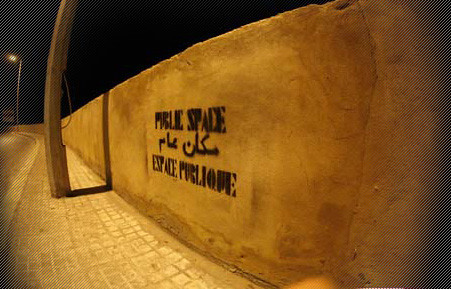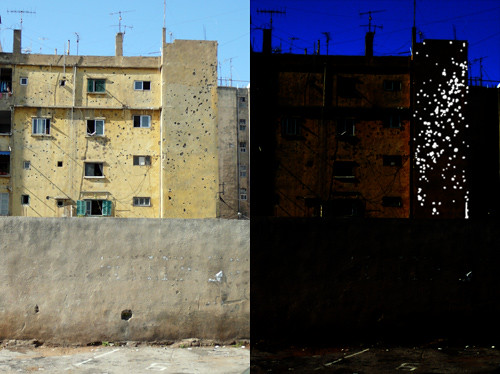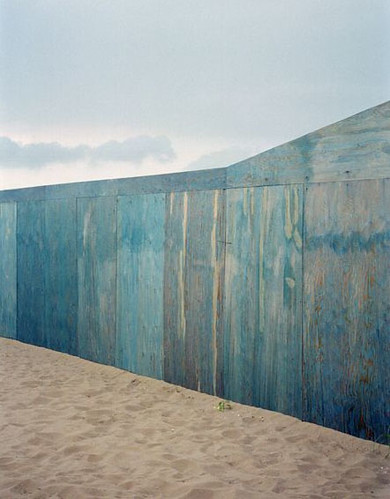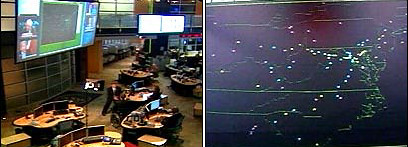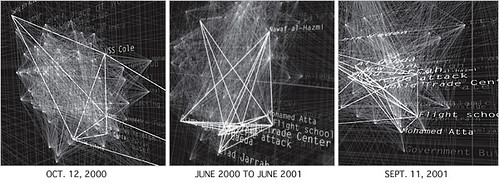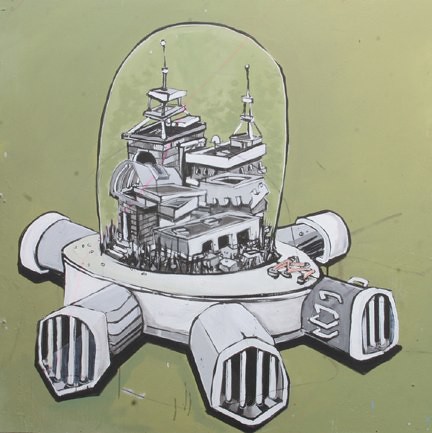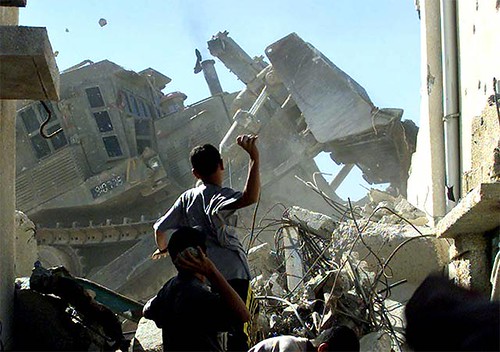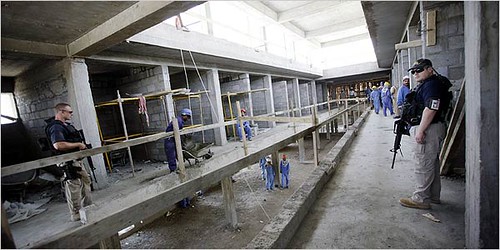Orwellian Wormholes
Simply dubbed the “Tunnel Team” - a group of eighteen specialized Border Patrol agents who’ve been trained “in confined spaces and hand-to-hand combat” - was recently featured on a television news segment guarding the storm drain tunnels and underground passageways that extend below the border city of Nogales where Arizona and Sonora, Mexico meet.
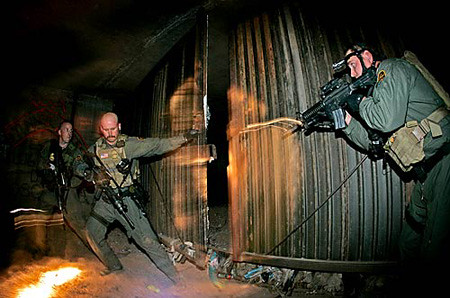
[Image: Border Patrol agents open a gate that defines the U.S./Mexico border under Nogales. Photo by Don Bartletti / LAT.]
Around the clock this nocturnal crew claws its way through the foliage of one of the world’s darkest urban jungles where an immeasurable number of smugglers, bandits and courageous migrants cross paths with them every day often times without even knowing it. In fact, Richard Marosi, who recently wrote an unbelievably illuminating article on the topic for the Los Angeles Times (that I highly encourage you to read) – writes, it is so dark that the team’s high-tech night vision goggles are almost rendered completely useless in the tunnel's black hole-like reaches. One of the agents even said, "It's so dark, you feel vertigo — like the walls are coming in on you."
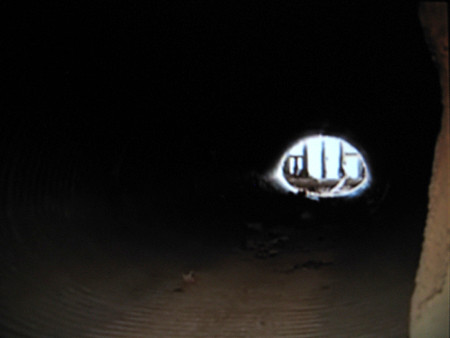
And so, welcome to the brave new world of cross-border tunnel migration and militarization – and, what could be the glimpse of a future (sub)urban world as more nation states wall off their borders from the increasing flows of global migration. Border tunnels are nothing new to Subtopia – in fact, we’re fascinated and want to write a crazy book about them and other counter-empire landscapes. But before we do, the Tunnel Team is waiting.
Wandering inside an imperceptibly sprawling black maze of asphyxiating hydrologic tubes and flooded hallways, this elite squad of tunnel rats tends to a whole range of preventative installations set up deep inside the bowels of this vast invisible borderlands architecture.
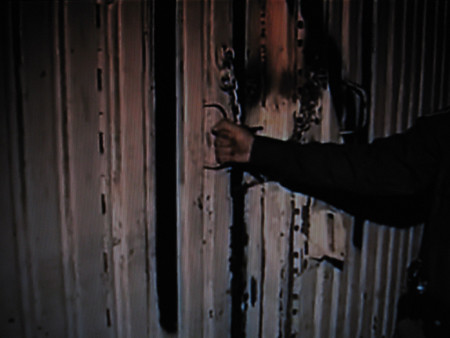
As they scoot through a long-winded knot of dank voids and jagged apertures, part of their job is to repair the heavy steel gates and other grates that have burst open from the pressures of recent floods, or have been hacked apart by coyotes determined to wormhole their way through the decrepit sewers – either way these openings look like timeless medieval valves leading to yet more unknown circles of Hell. And while maintaining a network of thermal vision surveillance cameras hidden in the bat infested corners of Nogales’ toxic netherworld, the agents regularly test other key remote sensors scattered more critically near the two main tunnel entrances – they even monitor various strategically placed rocks through out the substructure that act as trip wires, so, when moved, indicates that trespassers have come through.
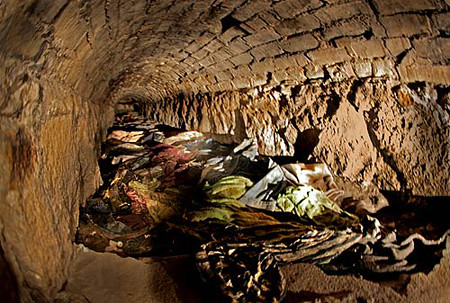
[Image: Trails of discraded clothes and blankets inside a Nogales drainway. Photo by Don Bartletti / LAT.]
[Real quick - on that basis alone I’m sending Mike Rowe from the Discovery Channel’s Dirty Jobs an email to this post, since he’s been whining about running low on things to keep him busy. One condition though: Mike, if you’re reading this and decide to go, be sure to take me with you.]
Anyway, through a bunch of news stories I soon discovered that the sewage infrastructure there is a hollow skeleton of Nogales itself – or, rather a gnarled intoxicated beast that has for decades choked the communities of both nations.
In Marosi’s article, we learn a brief history of the tunnels. For years, he says, “Illegal immigrants have breached drainage systems all the way along the border, from El Paso to San Diego. Most of them are of the claustrophobic crawl-through variety that prevents large-scale incursions”, or “gopher holes” as the military calls them. The Nogales tunnels, however, which are subsets of entire watershed infrastructure, are - by comparison, he says – borderzone superhighways.
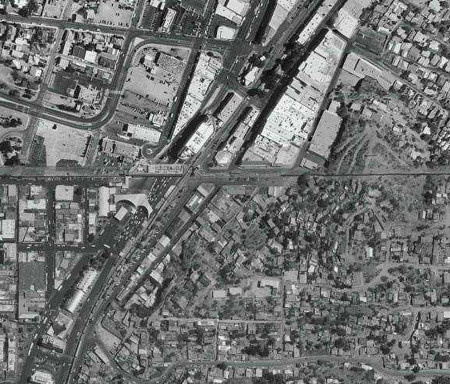
[Image: An aerial photography of Nogales, Arizona, and Nogales, Sonora, from a Critical U.S.- Mexico Borderland Watershed Analysis, Twin Cities Area Of Nogales, Arizona And Nogales, Sonora By Laura Margaret Brady, Floyd Gray, Mario Castaneda, Mark Bultman, and Karen Sue Bolm.]
”Once open waterways, today they stretch for miles under the traffic-clogged downtown streets of both cities, zigzagging roughly parallel to each other. […] In the smaller one, called the Morley Tunnel, an ankle-high stream of raw sewage and chemical runoff from factories in Mexico usually flows. The neighboring Grand Tunnel is up to 15 feet high and wide enough to fit a Humvee.”
The Morley Tunnel, though, is apparently so profuse with ammonia and chlorine stench that U.S. agents won’t even venture into it because of the sickness and nausea it induces. More dangerous even, since the tunnels were built to facilitate the spill off of monsoon rains they become extremely dangerous during certain parts of the year. Marosi indicates that this summer alone, at least five people were presumed trapped and drowned in floodwater.
For a good overview of the unique characteristics of the “Ambos Nogales” watershed and how it shapes a more enlightening diagnosis of the border condition in general, you can refer this GIS document. It’s also an interesting read because through its mapping of the degraded hydrology it conjures a historic reflection on the failed bi-national cooperation that has festered between the U.S. and Mexico for decades; the watershed becomes a literal reflection of their grossly negligent relationship. Talks about flash floods and population growth bring to surface evidence of avoided political dialogue over the exclusivity of the sewage infrastructure and its poor planning, and Nogales’ overall inadequate distribution of water supply through out the local region. We also learn that back in the 60’s, considerable amounts of Trichloroethylene (TCE) had been dumped at the United Musical Instrument factory near Meadow Hills, for which the people of Nogales fear today has left a dangerous plume of carcinogens in the local wells and wetlands areas. Then, we read how most of the colonias in the area haven’t even got access to proper waste management, and quickly it becomes obvious how the whole site seems to have played out as some sort of de facto ‘environmentally toxic’ border fence.

[Image: A satellite image of Nogales, Arizona, and Nogales, Sonora, from a Critical U.S.- Mexico Borderland Watershed Analysis, Twin Cities Area Of Nogales, Arizona And Nogales, Sonora By Laura Margaret Brady, Floyd Gray, Mario Castaneda, Mark Bultman, and Karen Sue Bolm.]
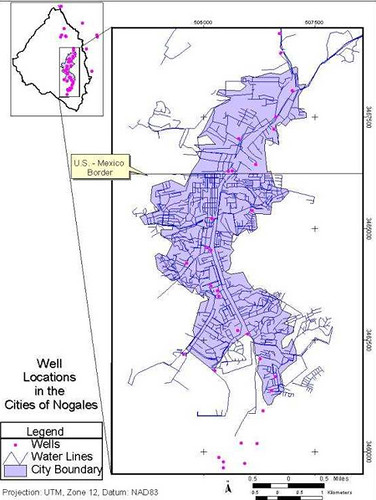
[Image: Well locations and water delivery lines within the Nogales watershed, as mapped in a Critical U.S.- Mexico Borderland Watershed Analysis, Twin Cities Area Of Nogales, Arizona And Nogales, Sonora By Laura Margaret Brady, Floyd Gray, Mario Castaneda, Mark Bultman, and Karen Sue Bolm.]
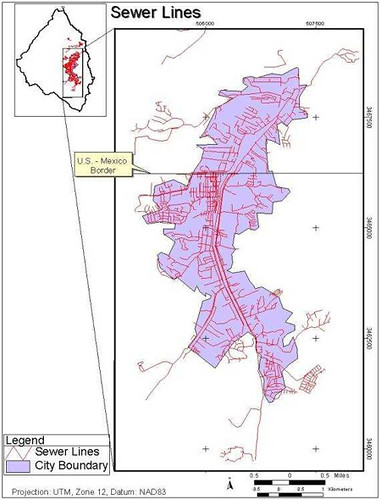
[Image: Sewer lines in the cities of Nogales, as mapped in Critical U.S.- Mexico Borderland Watershed Analysis, Twin Cities Area Of Nogales, Arizona And Nogales, Sonora By Laura Margaret Brady, Floyd Gray, Mario Castaneda, Mark Bultman, and Karen Sue Bolm.]
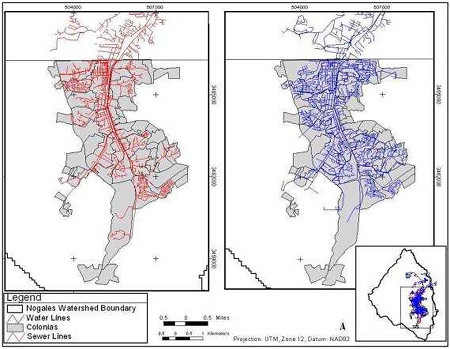
[Image: "Similar to the water delivery lines, sewer lines in the city of Nogales, Sonora are distributed according to monetary supply vs. human need; the colonias are not equipped with sewer lines at all. Image depicting those colonias in Nogales, Sonora that have no access to sewer and water delivery lines - as mapped in a Critical U.S.- Mexico Borderland Watershed Analysis, Twin Cities Area Of Nogales, Arizona And Nogales, Sonora By Laura Margaret Brady, Floyd Gray, Mario Castaneda, Mark Bultman, and Karen Sue Bolm.]
Essentially, the infrastructure has been left an exhausted corpse of overgrown concrete appendages and flogged lungs that today becomes a kind of mysteriously populated anti-city lurking below the real city above. It’s partly a thriving subterranean landscape with thousands of people traversing and living and conducting their own brand of commerce, but it’s also partly a massive industrial grave stewing with noxious hazards and quiet anonymous deaths. Maybe these giant tunnel-bored metacarpals fingering the earth will one day come to be revealed as the U.S./Mexico’s border equivalent of the Indian ghats infamously situated along the Ganges river - water levels raising and lowering while more and more borderzone settlements take to the underground in light of the increased immigration surveillance cementing itself at ground level.
With impending natural disasters due to climate change, and the continual siphoning of wealth to the very top of the socio-economic pyramid, the underground will perhaps serve as the last remaining refuge for the hyper-population movements of migrants, refugees and global squatters. But I digress...
Like some intrepid crew member scouring the intestinal spaces of an abandoned Hollywood space ship, Marosi says, “Sometimes the tunnel itself seems to be alive, producing from the humming and air flows a pulsing, low groan.”
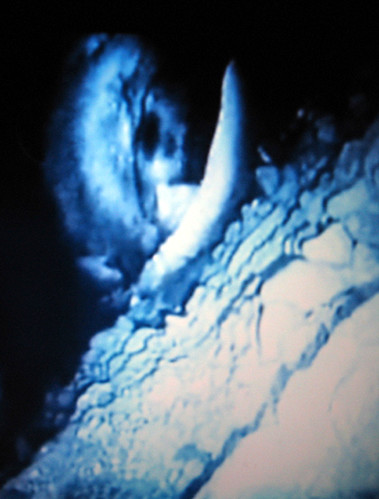
I mean, it’s a scene straight out of Alien - Nogales’ hollow chambers hemorrhaging with far off drips and foreign gurgles that seem to come from nowhere and everywhere at the same time. A creepy techno-swampish soundtrack slithers behind the ears – it stalks the audience with an impossibility of silence. The theater suddenly goes pitch black. There is a kind of even eerier quiet for a brief second - the fumage of diverse shits and rank sewage cinches the nostrils. Then, the flicker of a woozy flashlight roaming over complexions of mold-encrusted concrete re-appears.
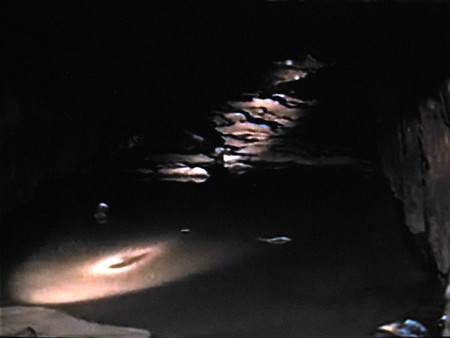

<[Image: Border Patrol agents inspect a drain tube for migrants that leads to Mexico. Photo by Don Bartletti / LAT.]
Picking up on a broken trail of dropped cell phones, discarded batteries, busted flashlight parts, Styrofoam kneepads, shreds of random clothing, a lost shoe, and a puddle of permanently undried blood, the Tunnel Team stops to fish out a drug smuggling pan from the mouth of a polluted river. Then they cut away a makeshift rope and pulley system that coyotes and drug smugglers have ingeniously rigged for guidance and circulating contraband. The agents paint over painted tags and remove strips of duct tape that serve as navigational clues for border crossers and confiscate stashes of hidden weapons that turn up under the chance glance of one of their hi-tech torches.
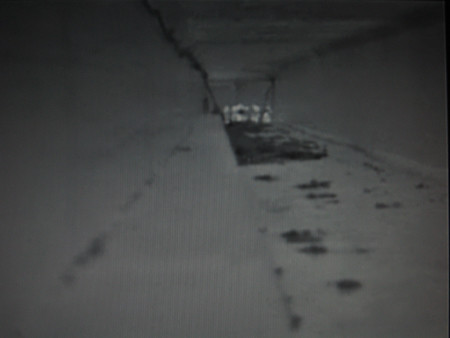

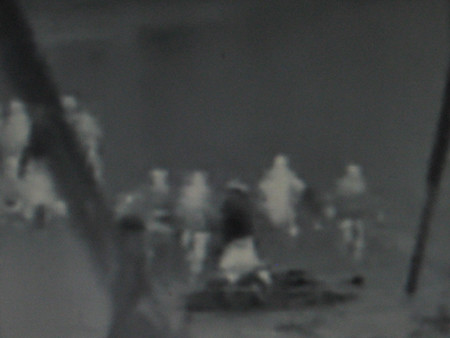
Tracking a group of migrants they lurk in corners against walls, being careful not to brush up against a tangle of exposed rebar, Marosi says, with “points sharpened by smugglers” waiting to “gouge people who get too close,” - and wait for them to pass “within an arm's length” before pouncing on them.
The Tunnel Team has only been in operation for a couple of months now but has already encountered “rapes, shootouts”, “methamphetamine-addicted assailants” and “young men working as drug mules [who] lug burlap sacks filled with contraband.”
One of the latest Nogales drug tunnels discovered only a couple of weeks ago had been hand dug along side the I-19 freeway and outfitted with a rope so that all the transport car needed to do was park momentarily beside the hole, swing open its door, haul up and unload the goods. According to this news segment from Channel 4, the rope systems are elaborate enough now between tunnel entrances that bodies are no longer even needed to go down into the tunnels and physically move the drugs. Attach them to a tray, pull a rope back and forth, and just like that - Done.
The same segment also states that “every 24 hours, the Tucson Sector is seizing 2,000-to-4,000 pounds of narcotics.” Numbers that have never been seen before. However, an interesting side note to that comes from a new report which claims the number one crop in America is now (un)officially - marijuana, reeling in an estimated $35b a year, “far more than the crop value of such heartland staples as corn, soybeans and hay, which are the top three legal cash crops.”
Morasi puts the number in terms of illegal immigrants that have been snatched in the tunnels from July through October, which is something like 1,704.
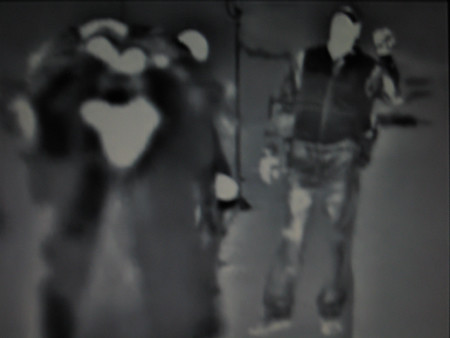
In an even bigger picture it looks like smuggler tunnels are completely taking over the border. For a while there it seemed like they were finding a new one almost every week. Approximately 40 have been uncovered linking cities in Arizona and California with Mexico since illegal immigration became such a focus. Some of the largest ones which crept up in and around San Diego and Tijuana are, we are told by Reuters, being constructed by “rogue mining engineers” brought in by cartels “to dig industry standard shafts and galleries." I have heard one report that one tunnel was discovered as deep as nine stories below the street. They are dug under homes, inside the floors of factory buildings. And while a couple of Mexican customs officials were recently busted for running one of the illegal border tunnels near Tijauana, numerous reports about U.S. Border Patrol agents being apprehended at street level checkpoints for allegedly trying to smuggle in military ammunition into Mexico – something the Mexican government has claimed as a long standing problem with the U.S. Border Patrol for years. Seven migrants a month or so ago had to be rescued from a drainage pipe in Otay Mesa after getting stuck in its narrow jaws. And it seems like at least every month we hear about some new tunnel being found, or sealed up with concrete, frivolously collapsed on some border crossers - not just along the border with Mexico, either. Even though the Canadian border isn’t riddled with tunnels the same way the Mexican is, several months ago a massive and fairly sophisticated tunnel was uncovered.
While preventing access to the tunnels remains the patrol’s top priority, the other side of the coin is watching all of the manholes that migrants use to make their escapes into the U.S. once they have successfully navigated the sewers and storm drains under places like Otay Mesa.

The 23-mile labyrinth of drainage pipes under Otay Mesa “leads to about 500 manholes scattered across about three square miles. From those openings into the bowels of the city, mud-covered migrants crawl out into streets, busy intersections and parking lots, creating a dizzying guessing game for U.S. Border Patrol agents.”
From the same Reuters article:
Unlike Nogales, the drainage system under Otay Mesa doesn't extend into Mexico but is just a hop and a skip away from the border. Hundreds of migrants have been arrested in the last year popping up from out of the drains. So far I think I read they have documented at least 80 confirmed exit point used by migrants.
The problem has grown serious enough that agents are teaming up with San Diego city engineers to create a computer map of the tunnel outlets and manhole system. Sensors will probably be installed soon on the manhole covers to alert when they are opened. But, in the meantime a dozen have been welded shut.
According to the article while “Policing the city's storm drain system is the responsibility of the Border Patrol” when it comes to unearthing drug tunnels, another task force beyond the ones like the Tunnel Team in Nogales claims jurisdiction.

[Image: The exit hole for the tunnel in Otay Mesa, photographed by Howard Lipin for the San Diego Union Tribune.]
Enter the federal Tunnel Task Force.
Based in San Diego the team, Reuters goes on to tell us, pools the resources of the U.S. Drug Enforcement Administration, Immigration and Customs Enforcement (ICE), the Border Patrol and Customs and Border Protection, and it draws support from a special U.S. military unit from an El Paso, Texas.
If you want to get more technical, Tunnel Task Force engineers are using “geo-science technologies including ground radar, magnetometers and seismic detectors” to sniff the trail of "discreet voids left by man-made tunnels.” They’ve even begun digging their own tunnels in order to test equipment. But - not without their own skepticism.
And, as a matter of law, Congress earlier this year passed the Border Tunnel Prevention Act (Signed Into law) – which really only technically now makes it a crime to knowingly construct, finance, or allow the construction of an unauthorized tunnel across a U.S. international border. Individuals caught using such a tunnel to smuggle aliens, contraband, drugs, weapons, or terrorists face penalties of more than 20 years in jail.
But imagine, if you will, the entire planet one day completely dug out like some Leviathan cavity, some twisted circuitous earth-embedded vault full of warring micronations - of renegade mining teams, refugee excavators, and illicit tunnel-trade armies. What if the world above falls to ruin (from natural disaster, civil war, genocide, urban warfare, economic and environmental injustice) and below is eventually turned into a hollow root system for future subterranean populations of subtopian squatters, entombed survivors, drainage system dwellers, mine hijackers; the whole thing fissured into a vast international platform of networked shafts and secret galleries linking transborder mazes with mudrucker migration roads from China to Mexico; buried arteries pumping with global labor flows knotting through space, threading undetected twists and turns around the militarized tunnel architecture of the UN who tries desperately to prevent such base incursions. What if the more nation-states harden their borders above ground, the more they rot themselves away underground – and border geographies naturally become the sites for a de facto global border tunnel design? Just check out Gaza.
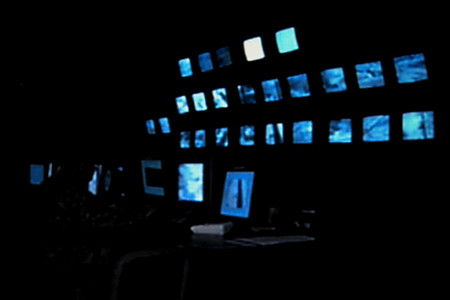
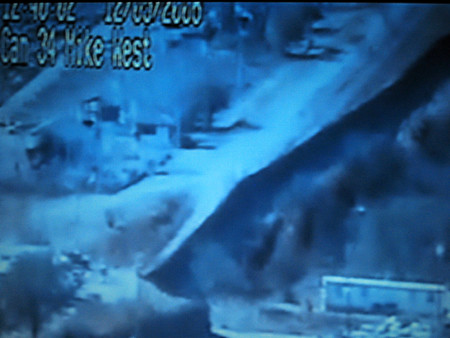
"Could they build a tunnel under the Rio Grande?" one official joked in the Reuters piece. "It really is just an engineering question. If the money is right for them, they can do whatever is possible."
(All images without captions were captured from the Channel 4 news video segments listed below.)
Videos:
Nogales Tunnel Team patrols 24/7
Border Patrol finds two drug tunnels in Nogales
News 4 explores Nogales tunnels
Articles:
Tunnels act as highways for migrants by Richard Marosi
Tunnel Task Force (Reuters)

[Image: Border Patrol agents open a gate that defines the U.S./Mexico border under Nogales. Photo by Don Bartletti / LAT.]
Around the clock this nocturnal crew claws its way through the foliage of one of the world’s darkest urban jungles where an immeasurable number of smugglers, bandits and courageous migrants cross paths with them every day often times without even knowing it. In fact, Richard Marosi, who recently wrote an unbelievably illuminating article on the topic for the Los Angeles Times (that I highly encourage you to read) – writes, it is so dark that the team’s high-tech night vision goggles are almost rendered completely useless in the tunnel's black hole-like reaches. One of the agents even said, "It's so dark, you feel vertigo — like the walls are coming in on you."

And so, welcome to the brave new world of cross-border tunnel migration and militarization – and, what could be the glimpse of a future (sub)urban world as more nation states wall off their borders from the increasing flows of global migration. Border tunnels are nothing new to Subtopia – in fact, we’re fascinated and want to write a crazy book about them and other counter-empire landscapes. But before we do, the Tunnel Team is waiting.
Wandering inside an imperceptibly sprawling black maze of asphyxiating hydrologic tubes and flooded hallways, this elite squad of tunnel rats tends to a whole range of preventative installations set up deep inside the bowels of this vast invisible borderlands architecture.

As they scoot through a long-winded knot of dank voids and jagged apertures, part of their job is to repair the heavy steel gates and other grates that have burst open from the pressures of recent floods, or have been hacked apart by coyotes determined to wormhole their way through the decrepit sewers – either way these openings look like timeless medieval valves leading to yet more unknown circles of Hell. And while maintaining a network of thermal vision surveillance cameras hidden in the bat infested corners of Nogales’ toxic netherworld, the agents regularly test other key remote sensors scattered more critically near the two main tunnel entrances – they even monitor various strategically placed rocks through out the substructure that act as trip wires, so, when moved, indicates that trespassers have come through.

[Image: Trails of discraded clothes and blankets inside a Nogales drainway. Photo by Don Bartletti / LAT.]
[Real quick - on that basis alone I’m sending Mike Rowe from the Discovery Channel’s Dirty Jobs an email to this post, since he’s been whining about running low on things to keep him busy. One condition though: Mike, if you’re reading this and decide to go, be sure to take me with you.]
Anyway, through a bunch of news stories I soon discovered that the sewage infrastructure there is a hollow skeleton of Nogales itself – or, rather a gnarled intoxicated beast that has for decades choked the communities of both nations.
In Marosi’s article, we learn a brief history of the tunnels. For years, he says, “Illegal immigrants have breached drainage systems all the way along the border, from El Paso to San Diego. Most of them are of the claustrophobic crawl-through variety that prevents large-scale incursions”, or “gopher holes” as the military calls them. The Nogales tunnels, however, which are subsets of entire watershed infrastructure, are - by comparison, he says – borderzone superhighways.

[Image: An aerial photography of Nogales, Arizona, and Nogales, Sonora, from a Critical U.S.- Mexico Borderland Watershed Analysis, Twin Cities Area Of Nogales, Arizona And Nogales, Sonora By Laura Margaret Brady, Floyd Gray, Mario Castaneda, Mark Bultman, and Karen Sue Bolm.]
”Once open waterways, today they stretch for miles under the traffic-clogged downtown streets of both cities, zigzagging roughly parallel to each other. […] In the smaller one, called the Morley Tunnel, an ankle-high stream of raw sewage and chemical runoff from factories in Mexico usually flows. The neighboring Grand Tunnel is up to 15 feet high and wide enough to fit a Humvee.”
The Morley Tunnel, though, is apparently so profuse with ammonia and chlorine stench that U.S. agents won’t even venture into it because of the sickness and nausea it induces. More dangerous even, since the tunnels were built to facilitate the spill off of monsoon rains they become extremely dangerous during certain parts of the year. Marosi indicates that this summer alone, at least five people were presumed trapped and drowned in floodwater.
For a good overview of the unique characteristics of the “Ambos Nogales” watershed and how it shapes a more enlightening diagnosis of the border condition in general, you can refer this GIS document. It’s also an interesting read because through its mapping of the degraded hydrology it conjures a historic reflection on the failed bi-national cooperation that has festered between the U.S. and Mexico for decades; the watershed becomes a literal reflection of their grossly negligent relationship. Talks about flash floods and population growth bring to surface evidence of avoided political dialogue over the exclusivity of the sewage infrastructure and its poor planning, and Nogales’ overall inadequate distribution of water supply through out the local region. We also learn that back in the 60’s, considerable amounts of Trichloroethylene (TCE) had been dumped at the United Musical Instrument factory near Meadow Hills, for which the people of Nogales fear today has left a dangerous plume of carcinogens in the local wells and wetlands areas. Then, we read how most of the colonias in the area haven’t even got access to proper waste management, and quickly it becomes obvious how the whole site seems to have played out as some sort of de facto ‘environmentally toxic’ border fence.

[Image: A satellite image of Nogales, Arizona, and Nogales, Sonora, from a Critical U.S.- Mexico Borderland Watershed Analysis, Twin Cities Area Of Nogales, Arizona And Nogales, Sonora By Laura Margaret Brady, Floyd Gray, Mario Castaneda, Mark Bultman, and Karen Sue Bolm.]

[Image: Well locations and water delivery lines within the Nogales watershed, as mapped in a Critical U.S.- Mexico Borderland Watershed Analysis, Twin Cities Area Of Nogales, Arizona And Nogales, Sonora By Laura Margaret Brady, Floyd Gray, Mario Castaneda, Mark Bultman, and Karen Sue Bolm.]

[Image: Sewer lines in the cities of Nogales, as mapped in Critical U.S.- Mexico Borderland Watershed Analysis, Twin Cities Area Of Nogales, Arizona And Nogales, Sonora By Laura Margaret Brady, Floyd Gray, Mario Castaneda, Mark Bultman, and Karen Sue Bolm.]

[Image: "Similar to the water delivery lines, sewer lines in the city of Nogales, Sonora are distributed according to monetary supply vs. human need; the colonias are not equipped with sewer lines at all. Image depicting those colonias in Nogales, Sonora that have no access to sewer and water delivery lines - as mapped in a Critical U.S.- Mexico Borderland Watershed Analysis, Twin Cities Area Of Nogales, Arizona And Nogales, Sonora By Laura Margaret Brady, Floyd Gray, Mario Castaneda, Mark Bultman, and Karen Sue Bolm.]
Essentially, the infrastructure has been left an exhausted corpse of overgrown concrete appendages and flogged lungs that today becomes a kind of mysteriously populated anti-city lurking below the real city above. It’s partly a thriving subterranean landscape with thousands of people traversing and living and conducting their own brand of commerce, but it’s also partly a massive industrial grave stewing with noxious hazards and quiet anonymous deaths. Maybe these giant tunnel-bored metacarpals fingering the earth will one day come to be revealed as the U.S./Mexico’s border equivalent of the Indian ghats infamously situated along the Ganges river - water levels raising and lowering while more and more borderzone settlements take to the underground in light of the increased immigration surveillance cementing itself at ground level.
With impending natural disasters due to climate change, and the continual siphoning of wealth to the very top of the socio-economic pyramid, the underground will perhaps serve as the last remaining refuge for the hyper-population movements of migrants, refugees and global squatters. But I digress...
Like some intrepid crew member scouring the intestinal spaces of an abandoned Hollywood space ship, Marosi says, “Sometimes the tunnel itself seems to be alive, producing from the humming and air flows a pulsing, low groan.”

I mean, it’s a scene straight out of Alien - Nogales’ hollow chambers hemorrhaging with far off drips and foreign gurgles that seem to come from nowhere and everywhere at the same time. A creepy techno-swampish soundtrack slithers behind the ears – it stalks the audience with an impossibility of silence. The theater suddenly goes pitch black. There is a kind of even eerier quiet for a brief second - the fumage of diverse shits and rank sewage cinches the nostrils. Then, the flicker of a woozy flashlight roaming over complexions of mold-encrusted concrete re-appears.


<[Image: Border Patrol agents inspect a drain tube for migrants that leads to Mexico. Photo by Don Bartletti / LAT.]
Picking up on a broken trail of dropped cell phones, discarded batteries, busted flashlight parts, Styrofoam kneepads, shreds of random clothing, a lost shoe, and a puddle of permanently undried blood, the Tunnel Team stops to fish out a drug smuggling pan from the mouth of a polluted river. Then they cut away a makeshift rope and pulley system that coyotes and drug smugglers have ingeniously rigged for guidance and circulating contraband. The agents paint over painted tags and remove strips of duct tape that serve as navigational clues for border crossers and confiscate stashes of hidden weapons that turn up under the chance glance of one of their hi-tech torches.



Tracking a group of migrants they lurk in corners against walls, being careful not to brush up against a tangle of exposed rebar, Marosi says, with “points sharpened by smugglers” waiting to “gouge people who get too close,” - and wait for them to pass “within an arm's length” before pouncing on them.
The Tunnel Team has only been in operation for a couple of months now but has already encountered “rapes, shootouts”, “methamphetamine-addicted assailants” and “young men working as drug mules [who] lug burlap sacks filled with contraband.”
One of the latest Nogales drug tunnels discovered only a couple of weeks ago had been hand dug along side the I-19 freeway and outfitted with a rope so that all the transport car needed to do was park momentarily beside the hole, swing open its door, haul up and unload the goods. According to this news segment from Channel 4, the rope systems are elaborate enough now between tunnel entrances that bodies are no longer even needed to go down into the tunnels and physically move the drugs. Attach them to a tray, pull a rope back and forth, and just like that - Done.
The same segment also states that “every 24 hours, the Tucson Sector is seizing 2,000-to-4,000 pounds of narcotics.” Numbers that have never been seen before. However, an interesting side note to that comes from a new report which claims the number one crop in America is now (un)officially - marijuana, reeling in an estimated $35b a year, “far more than the crop value of such heartland staples as corn, soybeans and hay, which are the top three legal cash crops.”
Morasi puts the number in terms of illegal immigrants that have been snatched in the tunnels from July through October, which is something like 1,704.

In an even bigger picture it looks like smuggler tunnels are completely taking over the border. For a while there it seemed like they were finding a new one almost every week. Approximately 40 have been uncovered linking cities in Arizona and California with Mexico since illegal immigration became such a focus. Some of the largest ones which crept up in and around San Diego and Tijuana are, we are told by Reuters, being constructed by “rogue mining engineers” brought in by cartels “to dig industry standard shafts and galleries." I have heard one report that one tunnel was discovered as deep as nine stories below the street. They are dug under homes, inside the floors of factory buildings. And while a couple of Mexican customs officials were recently busted for running one of the illegal border tunnels near Tijauana, numerous reports about U.S. Border Patrol agents being apprehended at street level checkpoints for allegedly trying to smuggle in military ammunition into Mexico – something the Mexican government has claimed as a long standing problem with the U.S. Border Patrol for years. Seven migrants a month or so ago had to be rescued from a drainage pipe in Otay Mesa after getting stuck in its narrow jaws. And it seems like at least every month we hear about some new tunnel being found, or sealed up with concrete, frivolously collapsed on some border crossers - not just along the border with Mexico, either. Even though the Canadian border isn’t riddled with tunnels the same way the Mexican is, several months ago a massive and fairly sophisticated tunnel was uncovered.
While preventing access to the tunnels remains the patrol’s top priority, the other side of the coin is watching all of the manholes that migrants use to make their escapes into the U.S. once they have successfully navigated the sewers and storm drains under places like Otay Mesa.

The 23-mile labyrinth of drainage pipes under Otay Mesa “leads to about 500 manholes scattered across about three square miles. From those openings into the bowels of the city, mud-covered migrants crawl out into streets, busy intersections and parking lots, creating a dizzying guessing game for U.S. Border Patrol agents.”
From the same Reuters article:
The migrant traffic below truck-clogged streets and new office parks underscores the persistence and desperation of people faced with crossing one of the most heavily fortified sections of the border.
The cat-and-mouse game took an ironic turn last month when migrants even surfaced outside the offices of the U.S. Border Tunnel Task Force. Those manhole covers — one in a secured parking lot — were welded shut after that, one of them also topped with three 35-pound bags of rocks and gravel.
But six more manholes, all potential escape hatches, lie within a block of the federal facility.
Unlike Nogales, the drainage system under Otay Mesa doesn't extend into Mexico but is just a hop and a skip away from the border. Hundreds of migrants have been arrested in the last year popping up from out of the drains. So far I think I read they have documented at least 80 confirmed exit point used by migrants.
The problem has grown serious enough that agents are teaming up with San Diego city engineers to create a computer map of the tunnel outlets and manhole system. Sensors will probably be installed soon on the manhole covers to alert when they are opened. But, in the meantime a dozen have been welded shut.
According to the article while “Policing the city's storm drain system is the responsibility of the Border Patrol” when it comes to unearthing drug tunnels, another task force beyond the ones like the Tunnel Team in Nogales claims jurisdiction.

[Image: The exit hole for the tunnel in Otay Mesa, photographed by Howard Lipin for the San Diego Union Tribune.]
Enter the federal Tunnel Task Force.
Based in San Diego the team, Reuters goes on to tell us, pools the resources of the U.S. Drug Enforcement Administration, Immigration and Customs Enforcement (ICE), the Border Patrol and Customs and Border Protection, and it draws support from a special U.S. military unit from an El Paso, Texas.
Originally called Joint Task Force Six, the combined-services unit was founded in 1989 to provide technical and intelligence support to federal police snaring drug traffickers on the Mexico border. It was renamed Joint Task Force North in 2004 and given an additional homeland security role.
The Tunnel Task Force was set up two years ago and meets weekly in a federal building close to the border. The search for tunnels is led by intelligence gathered by agents working with contacts on both sides of the border.
Its members are specialists in hunting for tunnels. Some learned their skills in the U.S. war in Afghanistan, where the search for al Qaeda leader Osama bin Laden initially focused on the Tora Bora caves and tunnel complexes near the Pakistan border.
If you want to get more technical, Tunnel Task Force engineers are using “geo-science technologies including ground radar, magnetometers and seismic detectors” to sniff the trail of "discreet voids left by man-made tunnels.” They’ve even begun digging their own tunnels in order to test equipment. But - not without their own skepticism.
And, as a matter of law, Congress earlier this year passed the Border Tunnel Prevention Act (Signed Into law) – which really only technically now makes it a crime to knowingly construct, finance, or allow the construction of an unauthorized tunnel across a U.S. international border. Individuals caught using such a tunnel to smuggle aliens, contraband, drugs, weapons, or terrorists face penalties of more than 20 years in jail.
But imagine, if you will, the entire planet one day completely dug out like some Leviathan cavity, some twisted circuitous earth-embedded vault full of warring micronations - of renegade mining teams, refugee excavators, and illicit tunnel-trade armies. What if the world above falls to ruin (from natural disaster, civil war, genocide, urban warfare, economic and environmental injustice) and below is eventually turned into a hollow root system for future subterranean populations of subtopian squatters, entombed survivors, drainage system dwellers, mine hijackers; the whole thing fissured into a vast international platform of networked shafts and secret galleries linking transborder mazes with mudrucker migration roads from China to Mexico; buried arteries pumping with global labor flows knotting through space, threading undetected twists and turns around the militarized tunnel architecture of the UN who tries desperately to prevent such base incursions. What if the more nation-states harden their borders above ground, the more they rot themselves away underground – and border geographies naturally become the sites for a de facto global border tunnel design? Just check out Gaza.


"Could they build a tunnel under the Rio Grande?" one official joked in the Reuters piece. "It really is just an engineering question. If the money is right for them, they can do whatever is possible."
(All images without captions were captured from the Channel 4 news video segments listed below.)
Videos:
Nogales Tunnel Team patrols 24/7
Border Patrol finds two drug tunnels in Nogales
News 4 explores Nogales tunnels
Articles:
Tunnels act as highways for migrants by Richard Marosi
Tunnel Task Force (Reuters)

